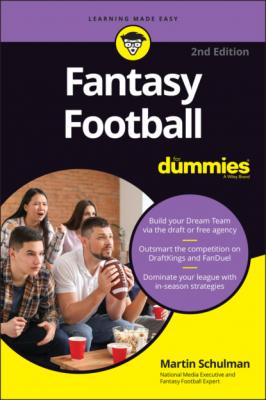Fantasy Football For Dummies. Martin A. Schulman
Читать онлайн.| Название | Fantasy Football For Dummies |
|---|---|
| Автор произведения | Martin A. Schulman |
| Жанр | Спорт, фитнес |
| Серия | |
| Издательство | Спорт, фитнес |
| Год выпуска | 0 |
| isbn | 9781119883340 |
Grasping salary cap draft rules
A fantasy salary cap draft works much like eBay, except that you offer on NFL players rather than antiques or gadgets. In a salary cap draft, each NFL player is assigned a unit value normally in dollars, and every fantasy team has a unit budget; each team must fill its roster requirements without going over budget. You can offer as much as you want for a player, as long as you still have enough units left to complete the rest of your roster. Often, but not always, these units are described as dollars.
For example, if you have a 20-player roster to fill and a budget of 200 dollars, the maximum you could offer for your first player would be 181 dollars, which would leave you with 1 dollar per player for the remaining 19 slots. However, this would be absurd and doing so would leave your fantasy team in lots of trouble!
A salary cap draft still has rounds — the number of rounds mirrors the number of roster spots — but instead of drafting a player when it’s your turn in a round, you nominate a player and start the offering at an amount of your choice. If no other team outoffers you, the player is yours. If another team makes a offer, the offering continues until no team surpasses the highest current offer; the player is awarded to the highest offerer. Each coach can nominate one player per round; this process continues until all the rosters are filled. (Chapter 4 has more info on preparing for a salary cap draft, and Chapter 8 gives you some strategies.)
Daily Fantasy Football almost exclusively uses a salary cap based format (which isn’t the same as salary cap drafts). DFS usually have a salary cap of $50-60K per contest, rather than the $200 commonly used in traditional fantasy leagues that use salary cap drafts to put together their rosters prior to the season. (For more on Daily Fantasy, see Part 4.)
Drafting the Right Players for Your Roster
An NFL team has 53 players total, with 11 starters on offense and 11 starters on defense. Luckily, your fantasy roster won’t be as extensive or complex (unless you play in an extreme league, which is beyond this book’s scope). When you research your league and find out how many roster spots you have, you can turn your attention to preparing for your draft based on those requirements.
Quarterback (QB)
Wide receiver 1 (WR1)
Wide receiver 2 (WR2)
Running back 1 (RB1)
Running back 2 (RB2)
Tight end (TE)
FLEX (WR, RB or TE)
Kicker (K)
Team defense/Special teams (Team DEF/ST)
Six bench players
Breaking down positions
The major positions on your fantasy roster are the same as the major positions on offense in football. RBs take center stage in fantasy football, not QBs, and in Chapter 5, I explain why. WRs are the unsung heroes of fantasy football because they can score plenty of fantasy points, but they’re often overshadowed by RBs and QBs. However, with the introduction of Points Per Reception or PPR leagues, the WR has regained its pre-eminent position as a fantasy points machine. Only a few TEs are major parts of their teams’ offensive gameplans; thus, a TE’s impact on your fantasy team is often limited. As for the Ks, most of them get the job done, so you only need to draft one.
The last position in your starting lineup isn’t usually based on individual stats but on the stats of everyone on an NFL team’s defense as a whole, focusing on turnovers, points allowed, as well as Defense/Special Teams touchdowns. You select an NFL’s defense to start each week, and you score fantasy points based on everything from TDs to sacks (see Chapter 2). In almost all formats, special teams’ TDs are counted, but it’s very rare for return yardage to be counted as well; in these types of leagues, the DEF will be called D/ST.
More advanced leagues use individual defensive player (IDP) positions; in these types of leagues, you draft individual defensive players rather than the team DEF.
In addition to the starting lineup, each team also has backup players sitting on the “bench.” The size of your bench depends on the type of league you’re in and on how many starters you have. Most benches range from five to ten players. Every NFL team has one week of the season off (the bye week), all players face some tough Matchups, and injuries are sure to rear their ugly head, so your bench will play a huge role in deciding your fantasy fate.
Rating players with the fantasy formula
How do you know whom to draft and which players at each position are right for your team? Every league provider and fantasy expert site pre-ranks the players for you from top to bottom. These lists of players are also referred to as pre-rankings or cheat sheets. They’re quick reference tools you can use when deciding which player to draft next. (Check out Chapter 4 for more on cheat sheets.)
Skill + Opportunity = Success
When researching the NFL, you’ll be looking for the players with the talents needed to excel and whose teams give them chances to use those skills. I emphasize the fantasy formula in Chapters
